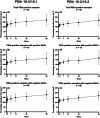Phosphatidylethanol in post-mortem blood: A comparative study of blood matrices and its stability at routine storage conditions
- PMID: 40572016
- PMCID: PMC12424113
- DOI: 10.1111/1556-4029.70106
Phosphatidylethanol in post-mortem blood: A comparative study of blood matrices and its stability at routine storage conditions
Abstract
Determination of alcohol markers in post-mortem cases can be useful to classify drinking habits and potential alcohol habituation prior to death. Phosphatidylethanol (PEth) is a direct alcohol marker and is already commonly used in a variety of contexts. However, its use in the field of post-mortem toxicology has been scarcely investigated so far. To evaluate its validity, PEth was determined in routinely collected post-mortem heart blood and femoral vein blood. The stability of PEth under routine storage conditions (-20°C) for a period of 60 days was examined. Post-mortem blood was collected during medicolegal autopsies and aliquoted. Parts of the samples were used to create dried blood spots (DBS) directly after collection. Further DBS were created using aliquots stored at -20°C on days 1, 2, 7, 14, 30, and 60. LC-MS/MS was used for quantitative PEth analysis, and initial blood alcohol was determined using GC-FID. Blood was collected from 50 different post-mortem cases. The heart blood/femoral blood ratio of PEth concentrations varied from 0.32 to 2.36 (mean = approx. 1.00), indicating a good comparability in total but a strong interindividual variation. In all PEth-positive samples, the PEth concentrations increased by approximately 20% after 24 hours and 70% after 60 days. Post-sampling formation of PEth was also found in blood samples without detectable amounts of ethanol. Neither storage at -80°C nor the addition of sodium metavanadate led to satisfactory stability of PEth. Based on our findings, the (sole) use of PEth for post-mortem toxicology caseworks is not recommended.
Keywords: alcohol biomarker; dried blood spots; femoral vein blood; forensic toxicology; heart blood; phospholipase D.
© 2025 The Author(s). Journal of Forensic Sciences published by Wiley Periodicals LLC on behalf of American Academy of Forensic Sciences.
Conflict of interest statement
The authors have no conflicts to declare.
Figures






References
Publication types
MeSH terms
Substances
LinkOut - more resources
Full Text Sources
Miscellaneous

